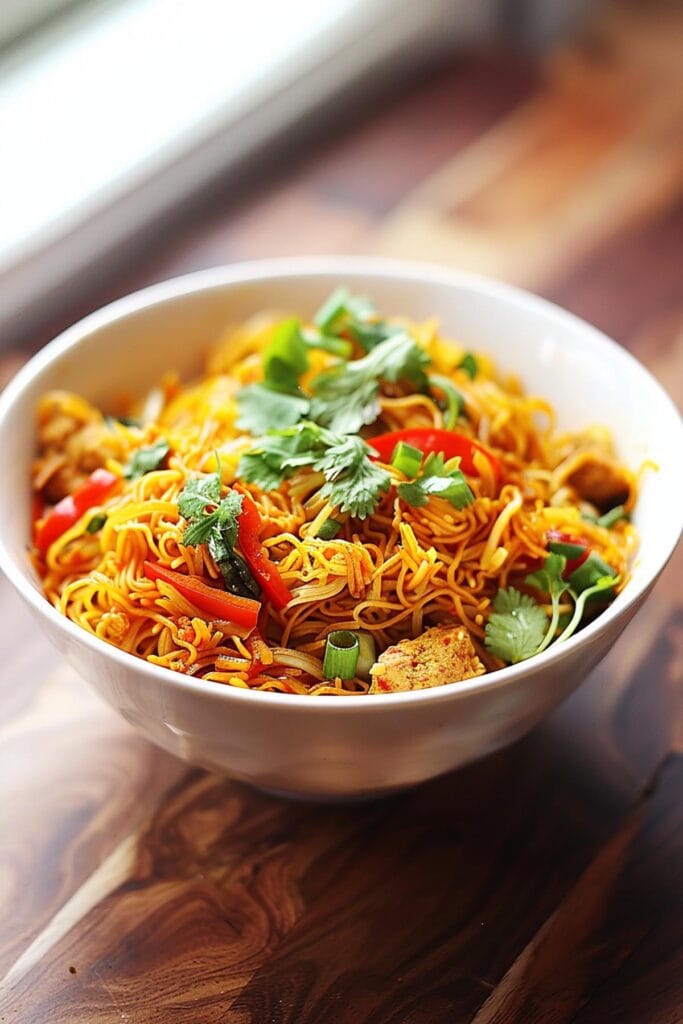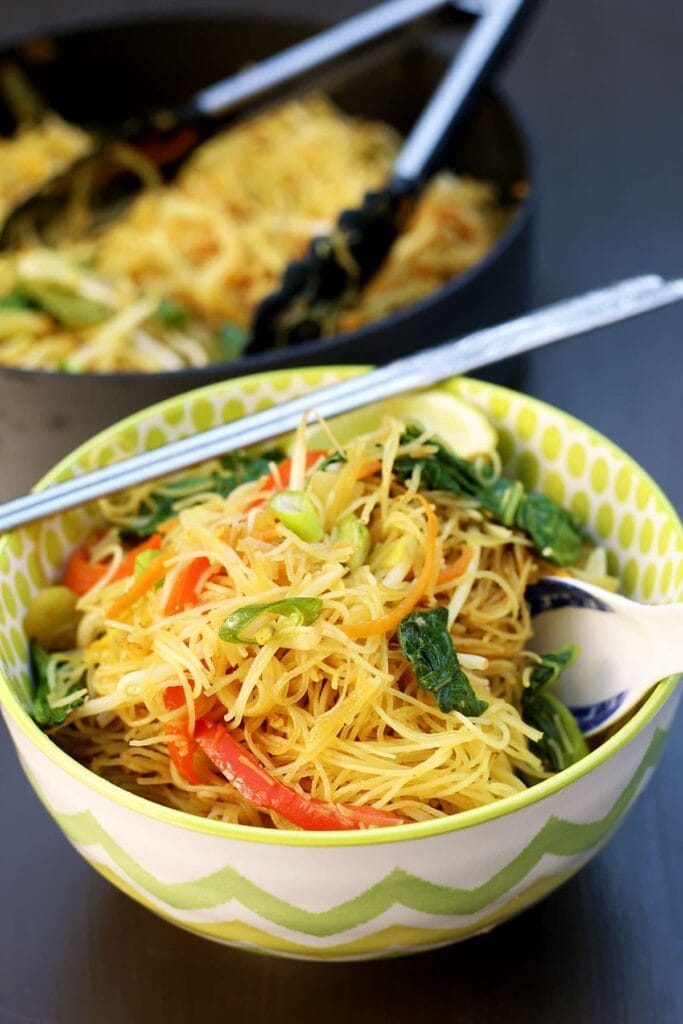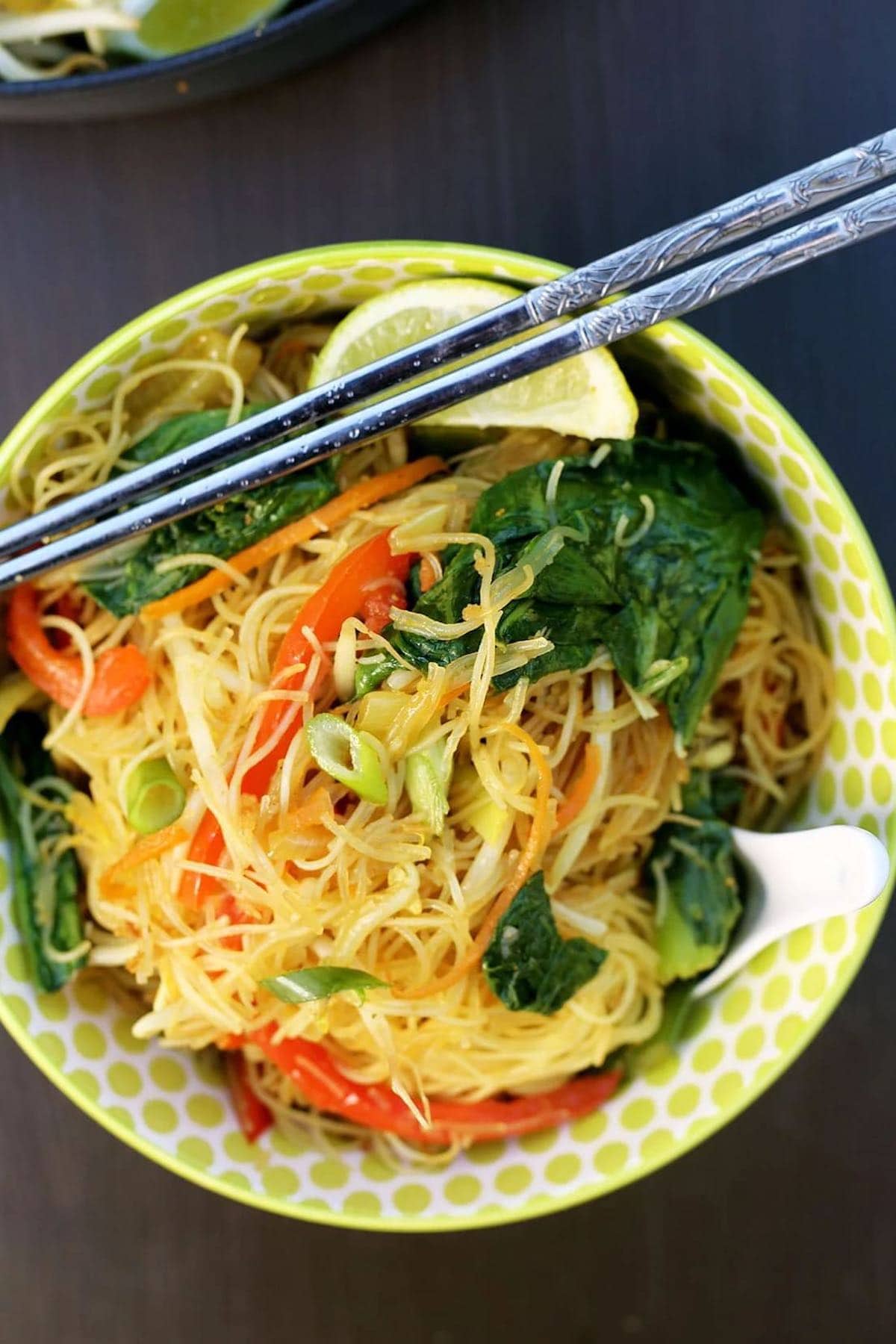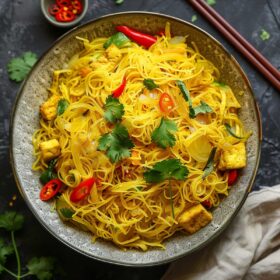Learn how to make this Singapore rice noodles recipe in the comfort of your own kitchen. It’s quick, easy, and tastes like something from a restaurant!
Some of my favorite Asian-inspired dishes include soba noodle salad, buddha bowls, and, of course, these wonderful Singapore rice noodles.

Quick and easy dinners are our jam, especially when no eggs are involved. You don’t have to head to Hong Kong to experience the amazing flavors of this dish, it can all be prepared easily at home.
FREE EBOOK SERIES! 5 SECRETS FOR FOOLPROOF VEGAN DESERTS
What are Singapore rice noodles?
Singapore rice noodles or Singapore style rice noodles are a traditional noodle dish from China, commonly made with shrimp and barbecue pork (also known as char siu). To prepare this version, stir-fried vegetables are mixed with cooked noodles. Unlike other noodles recipes, there is no soup left when these noodles are ready to go to the table.
Why this Singapore noodle recipe will be a dinnertime favorite:
- Ready in minutes. From prep to plate, this dish comes together in no time!
- Budget-friendly. No fancy ingredient is used: just cheap and affordable ingredients.
- Delicious. There is a reason why Singapore noodles are one of the most popular Asian dishes ever.
What I love the most about Singapore style rice noodles is how versatile they are when served with other meals. They especially taste great when paired with chicken, shrimp, or meatballs!
Ingredients needed
This recipe calls for very simple pantry staple ingredients that you probably already have on hand. Here is what you’ll need:
For the noodle base
- Vegetable oil. To cook.
- Onion. Chopped.
- Garlic. Minced.
- Red bell peppers. Medium green or yellow peppers also work, cut into thin strips.
- Snowpeas. Fresh or frozen.
- Carrot. Peeled and sliced into small pieces.
- Green/spring onions. Also known as scallions, should be fresh, and finely chopped.
- Beans sprouts. Without stalks.
- Bok choy. Chinese white cabbage.
- Thin rice vermicelli. Also known as thin rice noodles.
Seasoning ingredients
- Curry powder. To build rich aromatics.
- Vegetable stock. You can also use chicken stock.
- White pepper & salt. To taste.
- Sweet soy sauce. Adds a fabulous sweet and umami flavor.
- Tamari. Balances out the strong flavors of the soy sauce.
- Brown sugar. Or coconut sugar.
- Sesame oil. A flavorful oil that packs in tons of flavor.
How to make Singapore noodles
Simple is an understatement for this recipe. The pan takes care of all the hard work and you’ll have freshly cooked noodles in no time at all!
Step 1: Prepare the vermicelli noodles
To prepare the vermicelli noodles, soak them in cold water for at least 10 minutes.
Step 2: Stir fry veggies
Take a large wok or saucepan, and warm some oil in it over medium-high heat. Add onion, garlic, red pepper, snow peas, and carrots to stir fry until cooked through.
Step 3: Mix seasoning and noodles
With the help of the tongs, mix cooked noodles with stir-fried veggies. Add all the seasoning ingredients to create a sauce mixture and then stir this through the noodles well.
Step 4: Cook everything
Keep stirring until all the liquid in the wok is absorbed by the noodles. Then add bok choy and bean sprouts to the wok, stir fry and turn off the heat. After turning off the flame, add some sesame oil and mix it with everything.

Are Singapore rice noodles healthy?
Yes, Singapore rice noodles are healthy as they are packed with veggies and very little added sugar or fat. Pair it with some protein for a well-balanced meal.
Tips to make the best recipe
- Always cook the noodles in a non-stick wok or pan to keep them from sticking to the pot surface.
- For a more flavorful dish, swap out half the oil with toasted sesame oil. You could also add some ginger.
- Garnish with some chopped peanuts, fresh chili or even some cilantro for some flavor variation.
- Use a good quality non-stick wok or pan for perfectly cooked noodles.
Storage instructions
- To store. Keep the leftovers in airtight containers and store them in the refrigerator for 3-5 days.
- To freeze. Place the cooked and cooled noodles in a shallow container and store them in the freezer for up to two months.
- Reheating. You can reheat the stored noodles in the microwave or pan.

More noodle recipes to try
Frequently asked questions
Singapore noodles have a mild curry flavor with a subtle blend of spices, balanced by umami, a touch of sweetness, and the freshness of vegetables, often accompanied by a zesty citrus note.
Both dishes use different types of noodles. In Singapore noodles, vermicelli rice is used, but for chow mein, the noodles used are made of wheat.
No, these noodles aren’t gluten-free, as they are made of flour. However, you can make this recipe with any gluten-free noodles of your choice.
The base of this dish are rice vermicelli noodles. These are stir-fried with vegetables and seasoned with a mild curry, umami style sauce.

Singapore Rice Noodles | Easy Authentic Recipe
Ingredients
- 2 tablespoons Vegetable Oil
- 1 large White Onion sliced
- 4 cloves garlic minded
- 1 large bell pepper sliced
- 1 cup peas
- 1 large Carrot julienned
- 2 Green onions sliced
- 1 1/2 cups Bean Sprouts
- 2 Bok Choy
- 8 oz Rice Vermicelli
For the seasoning
- 2 teaspoons Curry Powder
- 1/2 teaspoon White Pepper
- 1 cup Vegetable Stock
- 2 teaspoons Sweet Soy Sauce
- 3 Tablespoons Tamari
- 1/2 teaspoon Brown Sugar
- 1 teaspoon Sesame Oil
Instructions
- Prepare vermicelli noodles by soaking in a large bowl of cold water for 10 minutes.
- In a large wok or saucepan, heat oil up. Gently stir fry garlic, onion, red pepper and snow peas for a minute, then add in carrot and spring onion. Continue stir frying until the veggies soften.
- Drain noodles from water and add into wok. Using tongs, loosen up the noodles so they cook evenly.
- Add all seasoning ingredients to the pan and make sure to keep moving the noodles around so they don’t burn or break up. Stir fry until all the liquid in the wok has been absorbed by the noodles. Taste for seasoning and alter to your preference.
- Add bean sprouts and bok choy into the wok. Toss to heat the veggies through and then turn off the heat. Add sesame oil after the heat has been turned off and stir to mix through.
Kay says
Amrita says
karissa says
Amrita says
Jeff says
Heather says
Victoria says
Amrita says
salkgnasdkjgnkajsdbfa says
Amrita says
Nina says
Amrita says